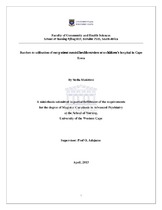| dc.description.abstract | This mini-thesis is an investigation of the barriers (if any) to utilisation of child and adolescent out-patient mental health services in the Division of Child and Adolescent Psychiatry at a children’s hospital in Cape Town, South Africa. It explores the reasons that make the patients not to honour their appointments. The study examines the relationship between the dependent variables (attendance (0), and non-attendance (1)), and independent variables which are demographic factors
(age, sex, education, race, employment, marital status, area of residence, form of treatment, diagnosis and frequency of missed appointments) and continuous variables (finance/costs, language, knowledge, stigma, support system, culture/religion, confidentiality, work, school, service, and other miscellaneous variables (forgetting, inconvenience, refusing, frequency of appointments, and
length of the session and emergency). The literature reviewed in the study revealed that non-attendance in mental health is a universal phenomenon, which affects everyone regardless of race, ethnicity or economic class. Furthermore, child mental health differs from other health fields in that almost all the patients are
brought for consultation, somehow, against their will (Eapen & Jairam, 2009).
In the study, the present researcher argues that even though non-attendance in child and adolescent psychiatry is a universal phenomenon, and literature is consistent in the findings on the barriers to utilisation of mental health services in other parts of the world, there is poor information on similar studies on South Africa, and particularly in Cape Town, where this study is based. This study will therefore contribute information to the existing body of knowledge in this area of child and adolescent mental health care services. iv The present researcher used a quantitative approach and Non-experimental design. Notably, the researcher used random stratified sampling with a population of patients who consulted with the
Division of Child and Adolescent Out-patient Psychiatry Unit and at Neuropsychiatry Outpatient Clinic from the 1st of January 2011 to the 31st of December 2011, who missed appointments, and those who never missed appointments. The researcher conducted a survey using self-administered structured questionnaires, with children from 9 years to 18 years, and all parents/caregivers. The data is analysed using the Statistical Package for the Social Sciences (SPSS) software, Version 19.0 and Descriptive and inferential statistics. Findings from this study showed that all other independent variables investigated are statistically insignificant and are not associated with non-attendance in this out-patient unit, except for school
related reasons which are found to be dominant possible barriers for attendance, and culture/religion is also statistically significant and has a weak association with non-attendance. These findings have implications on service delivery in this unit. Based on the findings, this mini-thesis concludes with a recommendation that services may possibly need to be reviewed to meet the needs of the patients in order to improve utilisation. I also recommend that this study be rolled out to other community clinics in the Western Cape, as it was done on a smaller scale, and
only in one out-patient unit. | en_US |

